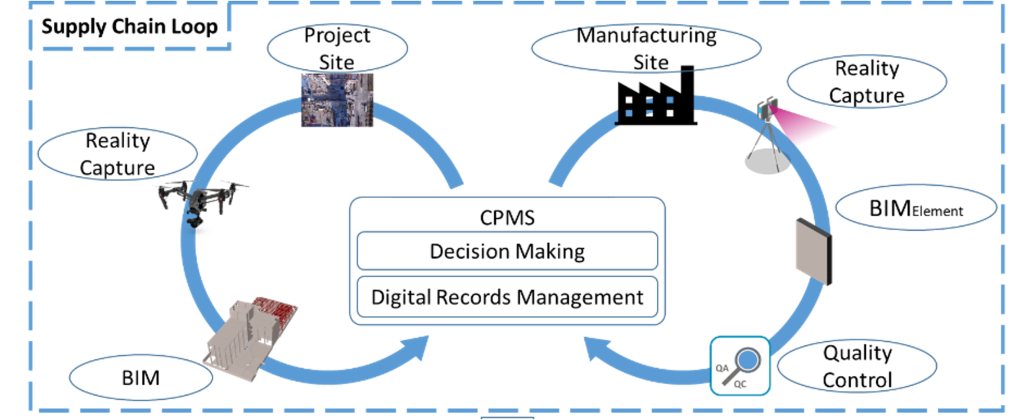
CPMS
Construction Performance Modeling and Simulation (CPMS) is an enterprise-grade cloud based digital engineering platform for high precision construction.
COMPRISK
Comprehensive Risk Assessment Tool (COMPRISK) is a unified platform designed to enhance Probabilistic Risk Assessment (PRA) driven design and decision making in critical facilities facing external and internal hazards.
CREST/CREST-IRS
CREST and CREST-IRS account for the interactions between building equipment-piping during seismic motions, the effect of non-classical damping, and the phasing among subsystems.
INCABS
INCABS is a powerful tool that uses a simple engineering approach to generate accurate Incabinet Response Spectra (ICRS) inside an electrical cabinet and control panel.
 Almost all mega infrastructure construction projects have experienced huge escalations in construction cost and schedule delays. The problem is further amplified in the construction of high precision nuclear energy facilities that have stringent quality standards. Modular construction is being envisioned as a solution to this problem, but its field implementation has experienced significant challenges even in non-nuclear construction projects with relatively less stringent regulations. This is due to a lack of technology that can provide comprehensive visualization and progress monitoring of modular systems. Digital technology can assist with early detection of problems in modular construction such as manufacturing deviations. It can also serve as a digital platform that can integrate design and as-built models, performance information, requirements, certifications, and approvals from diverse vendors and subcontractors.
Almost all mega infrastructure construction projects have experienced huge escalations in construction cost and schedule delays. The problem is further amplified in the construction of high precision nuclear energy facilities that have stringent quality standards. Modular construction is being envisioned as a solution to this problem, but its field implementation has experienced significant challenges even in non-nuclear construction projects with relatively less stringent regulations. This is due to a lack of technology that can provide comprehensive visualization and progress monitoring of modular systems. Digital technology can assist with early detection of problems in modular construction such as manufacturing deviations. It can also serve as a digital platform that can integrate design and as-built models, performance information, requirements, certifications, and approvals from diverse vendors and subcontractors.
PowerN has developed a digital platform CPMS (Construction Performance Modeling and Simulation) to address these issues using Augmented Reality (AR) and Artificial Intelligence (AI) environments. This AR-based Construction Performance Management can enable virtual assembly of modular components that are fabricated off-site, ensuring the quality and compatibility of different components before shipment, which can be further enhanced through our AI/machine learning (AI/ML) and robotics solutions. In addition, this technology enables a holistic approach to digital record generation and management in the supply chain loop. Every process of fabrication, assembly (both on-site and virtual), and inspection can be documented by as-built 3D point clouds and as-planned construction and fabrication models.
Probabilistic Risk Assessment (PRA) has emerged as a fundamental tool in the realm of risk-informed decision-making, particularly due to its ability to comprehensively account for the uncertainties and interdependencies inherent in complex systems. In recent years, the nuclear industry has increasingly adopted PRA methodologies as a cornerstone for the design, operational management, life extension strategies, and regulatory oversight of nuclear power plants. Other industries such as aerospace, healthcare, and energy infrastructure facilities have also relied increasingly on PRA models in recent years. PowerN has developed a unified platform designed to enhance PRA driven design and decision making in critical facilities facing external and internal hazards. The platform integrates multiple algorithms for systems analysis, crucial in PRA, to evaluate the fragility of structures, systems, and components (SSCs) using fault and event tree analysis. Recognizing that each Fault Tree Analysis (FTA) algorithm, including Binary Decision Diagrams (BDD), Zero-Suppressed BDD (ZBDD), Method of Obtaining Cut Sets (MOCUS), and Compressed Truth Tables (CTTs), has its own limitations and areas of superiority, the unified platform is tailored to leverage their collective strengths. By incorporating all these algorithms, the platform facilitates a thorough evaluation and comparison of their performance in various scenarios. The modular platform comprises of four components: initialization, optimization, analysis, and reporting. Our PRA platform significantly enhances the accuracy and efficiency of diverse and interdependent PRA models, enabling effective risk management in complex systems.
CREST and CREST-IRS disrupt the traditional approach for seismic analysis and design of equipment and piping systems in critical industrial facilities. They goes well beyond the conventional engineering which decouples the buildings and supporting structures from the equipment and piping connected to them. During an earthquake, the entire collection of buildings and the mechanical equipment or piping supported on the buildings act as a one single system. The earthquake behavior of such a connected system is different from the corresponding decoupled models in the sense that the mechanical equipment and piping subsystems end up being highly overdesigned. This has led to designs that are costly to build, shorter lifespans under operating conditions, and require excessive resources to operate and maintain. PowerN’s CREST are CRES-IRS are built upon several years of research and development. These tools account for the building-equipment-piping interactions, nonclassical damping, and phasing among subsystem. All these aspects are a reality during an earthquake but are ignored to simplify the traditional approach. Applications of CREST and CREST-IRS to several different nuclear plants worldwide have shown reductions in the seismic demands on mechanical subsystems by an order of magnitude. Such reductions have helped nuclear power plant owners with significant cost savings especially during major upgrades such as steam generator replacement projects.
Critical infrastructure facilities ranging from nuclear plants to data centers continue to rely increasingly on electrical equipment for digital control. During an earthquake, failure of these systems to operate as intended have the potential to cripple the communication networks, hinder emergency response after a major disaster, shutdown transportation networks, or even increase the risk of accident at a nuclear power plant. Seismic qualification of such electrical systems and equipment requires characterizing seismic demands using In-Cabinet (or In-Equipment) Response Spectra (ICRS). The nature of ICRS is highly dependent upon the seismic behavior of electrical cabinets and control panels that house the electrical control systems, switches, and relays. Development of ICRS using a complex 3D computer simulation of electrical control panels while feasible is highly impractical and time consuming.
INCABS is a powerful tool that uses a simple engineering approach to generate accurate ICRS and provides an excellent visualization of the earthquake behavior of electrical cabinets and control panels. INCABS has been developed rigorous experimental and simulation studies. Accurate calculation of ICRS using INCABS has helped engineers in nuclear power plants to eliminate excessive conservatism that has been built into ad-hoc approaches often used in hand calculations. PowerN’s team has used it successfully in seismic design and qualification of electrical substations as well as in seismic risk assessment of nuclear power plants.



